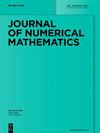Loosely coupled, non-iterative time-splitting scheme based on Robin–Robin coupling: Unified analysis for parabolic/parabolic and parabolic/hyperbolic problems
IF 4
2区 数学
Q1 MATHEMATICS
引用次数: 2
Abstract
Abstract We present a loosely coupled, non-iterative time-splitting scheme based on Robin–Robin coupling conditions. We apply a novel unified analysis for this scheme applied to both a parabolic/parabolic coupled system and a parabolic/hyperbolic coupled system. We show for both systems that the scheme is stable, and the error converges as O(ΔtT+log(1Δt)), $\mathcal{O}\big({\Delta t} \sqrt{T +\log(\frac{1}{{\Delta t}})}\big),$where Δt is the time step.基于Robin-Robin耦合的松耦合非迭代分时方案:抛物型/抛物型和抛物型/双曲型问题的统一分析
摘要提出了一种基于Robin-Robin耦合条件的松耦合非迭代时分裂方案。我们将该格式统一地应用于抛物型/抛物型耦合系统和抛物型/双曲型耦合系统。对于这两个系统,我们证明了该方案是稳定的,并且误差收敛为O(ΔtT+log(1Δt)), $\mathcal{O}\big({\Delta t} \sqrt{T +\log(\frac{1}{{\Delta t}})}\big),$,其中Δt是时间步长。
本文章由计算机程序翻译,如有差异,请以英文原文为准。
求助全文
约1分钟内获得全文
求助全文
来源期刊
CiteScore
5.90
自引率
3.30%
发文量
17
审稿时长
>12 weeks
期刊介绍:
The Journal of Numerical Mathematics (formerly East-West Journal of Numerical Mathematics) contains high-quality papers featuring contemporary research in all areas of Numerical Mathematics. This includes the development, analysis, and implementation of new and innovative methods in Numerical Linear Algebra, Numerical Analysis, Optimal Control/Optimization, and Scientific Computing. The journal will also publish applications-oriented papers with significant mathematical content in computational fluid dynamics and other areas of computational engineering, finance, and life sciences.

 求助内容:
求助内容: 应助结果提醒方式:
应助结果提醒方式:


